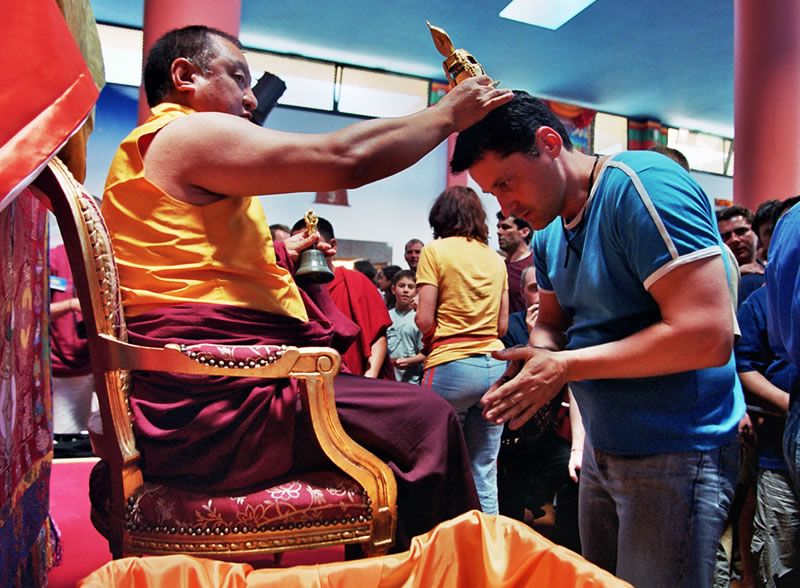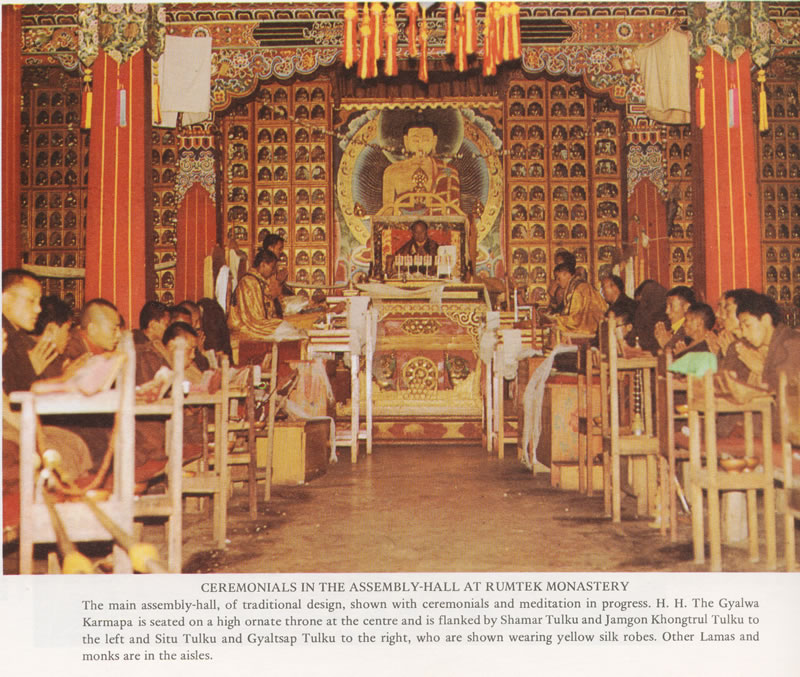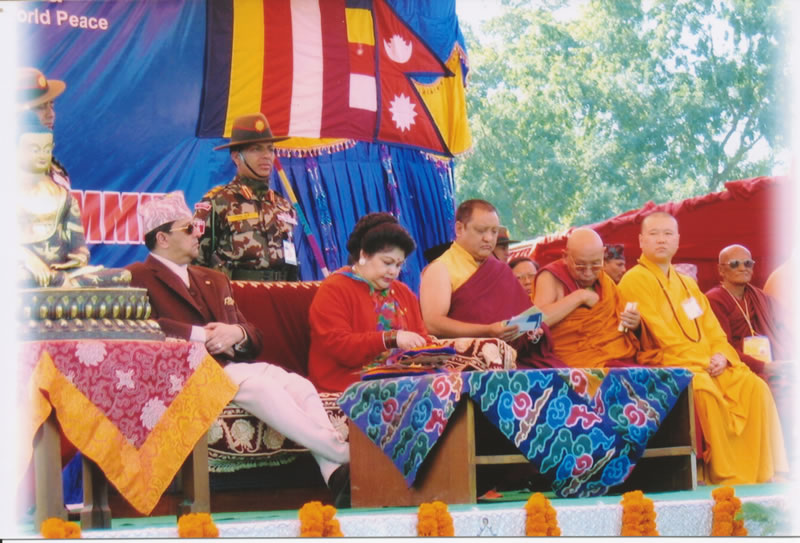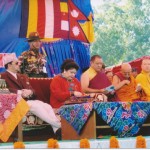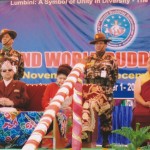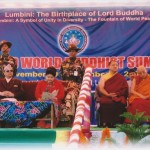First series of teachings by Shamar Rimpoche at the Bodhi Path Center, Renchen Ulm.
History of the house:
Shamar Rimpoche told me to look for a suitable house near Strasbourg, on the German side of the border. He was quite determined as far as the area was concerned. I was wondering why it was so important to look around in that particular area. Somehow I got the impression that Rimpoche had already seen the house before but meanwhile “forgot” the exact location of it. Without any further precise details I decided to conduct the search in my own way through local brokers. Then it happened 5 weeks later, on 28th October 2005, that I learnt about a building in Renchen-Ulm, which was previously used as a hotel and restaurant. I had a look at the house and was immediately very interested in it. On the other hand I thought it would be much too good and expensive for us. Still I phoned Shamar Rimpoche in America and just started to informed him about the details of the project, when he interrupted me and shocked me with his reply that this building was exactly the house he was “thinking” about. He instructed me , to go ahead with the purchase without any hesitation and, of course, also without his prior personal inspection or visit to Renchen-Ulm.
Shamar Rimpoche subsequently quickly decided regarding the future use of the existing facilities of the house as follows:
1. There are 5 comfortable, newly decorated hotel-rooms, each with an attached bathroom. They remain unchanged for the accommodation of visiting Dharma-Guests. These rooms can be rented also for longer periods of time.
2. The restaurant and the professional kitchen remain unchanged as well and will serve our guests in future before and after teachings. The kitchen will serve not only the restaurant but also visitors who prefer to sit outside on the spacious, open terrace in front of the building.
3. The bar will be used in future as well, but, of course, after all alcoholic drinks were removed. From now onwards the bar will exclusively serve our guests with juices, snacks, coffee and tea and lots of other healthy refreshments. It will be a place where our guests can enjoy their visit in a relaxed and comfortable athmosphere.
4. However, the large existing bowling-alley was converted into a splendid teaching hall, which is overlooking the beautiful garden. The teaching-hall can accomodate up to 100 persons at times of need.
At the same time there is a big public community-hall which can be rented for very special events. This was already done during this summer when Shamar Rimpoche gave his first teachings for us in this area. There were so many visitors that it was appropriate to rent the community-hall, which can be easily reached on foot from the centre.
Renchen-Ulm is not a big town, but we have discovered that there are many nice and clean private guesthouses (Bed & Breakfast) where visitors can stay overnight at very reasonable rates. This area is well-known for it’s outstanding service, good wine and food and it’s hospitality. Our Dharma- centre is happy to make the requested bookings, if requested, on behalf of those visitors who wish to make use of these facilities.
After we moved into the new centre, we quickly found out that the area is nearly perfect for us. Only a few minutes away from the centre there is a wonderful park with lots of green trees, lawns and a fast flowing fresh-water-stream, where the residents and visitors can enjoy a peaceful and tranquil day. It is a place for holiday-makers and people who are able to enjoy nature in a quiet environment.
Sabine Teuber
(Secretary of Bodhipath Centre Renchen-Ulm)
To see some pictures, click here
The new Bodhi Path Centre at Renchen Ulm on the Franco German border held its first large course over four week ends in July 2006
Jigme Rinpoche visited the prospective new centre in October 2005 and decided it would be a propitious place to open a new Bodhi Path Center in Germany, and the first residents moved into the house, a lovely building, originally constructed as a hotel in the 1970’s, in early 2006.
Lama Jigme Rinpoche gave an introductory teaching on the subject of Buddhist meditation in Strasbourg, 30 km from the center, on the 6th of July. The official program began on the 7th July, and over the first two weekends, Shamar Rimpoche gave a complete and thorough teaching on Samanthabhadra’s wishing prayers. He explained that all the great Bodhisattvas in India and Tibet have practice this prayer each morning and evening. Rinpoche stressed that following the wishes of Sa
manthabhadra is the greatest cause to participate in the Nirvana’s of Buddha’s life after life.
Lama Jigme Rinpoche also gave explanation teachings and answered questions.
During the third weekend Shamar Rimpoche gave instructions on and explained the 35 Buddha’s Sutra completely. Both of these two subjects are very important in the Bodhi Path curriculum.
Over the last weekend Shamar Rimpoche began teaching the philosophical curriculum with a teaching on the 5 skandhas.
Shamar Rimpoche announced that he will give further teachings from the Bodhi Path curriculum in the summer of 2007.
The center is able to accommodate about 35 guests, and good quality reasonably priced rooms are available in the area. There are a number of excellent restaurants nearby, and being in the black forest, the area is outstandingly beautiful.
The teachings were held in a wonderful modern hall near the center, with space for several hundred people.
Don’t miss next year’s teachings!
Program (2006):
Conference with Jigme Rinpoche in Strasbourg, July 6 at 8:00 pm. Topic – Meditation: How to Apply it in Daily Life.
Place – Salle Henade de Landseberg (Parking Austerlitz)
Address to contact for more information:
Maison des Associations
1 A Place des Orphelins
67000 Strasbourg
Web site : www.mdas.org
Teachings of Shamar Rimpoche at the Center near Strasbourg
Place: Bodhi Path – Buddhistisches Karma Kagyu Zentrum e.v
77871 Renchen-Ulm, Kaierstr. 18
Telephone: 07843-7232
Email: info@bodhipath-renchen-ulm.de
Web: http://www.bodhipath-renchen-ulm.de
The course will be four weekends in July 2006:
Friday, 7 July – Sunday, 9 July:
The King of Wishing Prayers (Samantabhadra), Part I
Friday, 14 July – Sunday, 16 July:
The King of Wishing Prayers (Samantabhadra) Part II
Friday, 21 July – Sunday, 23 July:
The Triskandhasutra and The Practice of the 35 Buddhas, Part I and II
Friday, 28 July – Sunday, 30 July:
Overview of the five skandhas, the three first in details :
1) form
2) feeling
3) perception
The teaching from Shamar Rimpoche on “The King of the Wishing Prayers” is based on the text The Treasury of Wishing Prayers, Sang Cheu Monlam.
The schedule for the four weekends will be as follows:
Fridays: Teaching with Jigme Rinpoche 4:00 pm and
Shamar Rimpoche 8:00 pm.
Saturdays: Teaching with Shamar Rimpoche 10:00 am and
Jigme Rinpoche 4:00 pm.
Sundays: Shamar Rimpoche will teach in the morning from 10:00 – 12:00.
Price: 55 euros per person for the 3 days of each weekend.
Food and Lodging:
There is no lodging available at the center, but there are many bed and breakfasts or hotels nearby in Germany.
On the French side, there are possibilities to stay in Strasbourg. For those on a budget there is a Formule 1 well placed in relation to the Buddhist center at 55 Route du Rhin, RN4. Telephone: (+33)89….
There is also Gambsheim, which is the same distance from the center and has a hotel and a campground (Hotel le Passage (tel: 03-88-6…), price for rooms: 40 euros for a double room; breakfast 5 euros).
There are no meals available at the center, but you may bring food for a picnic, or there are restaurants in the neighbouring villages.
How to get to the center:
By train: Go via Paris-Strasbourg and then Strasbourg-Offenburg or Ulm.
There is the possibility to send someone to pick you up at the train station (telephone: (49)-7843-7232).
By car: Go first to Strasbourg – the center is about 30 km from there.
Exit Strasbourg by the A35 direction Nancy, Metz, Offenburg, St. Die, Colmar. Then take Exit 4 Porte Shirmek, Etoile, Meinau, Montagne Verte, Kehl, Lingolsheim. Take the N4 direction Offenburg, then the B28 and a right on the B3 direction Appenweier. Go through Appenweier direction Renchen, and go through Renchen. Take a right to Ulm. When arriving in Ulm, on the main road, take a right direction Kaier. Go about 1.8 km and then you will see a collection of houses. The cente is on the right, with a sign saying Bodhi Path Center.
(The itinerary can be found on the website http://www.viamichelin.com)











